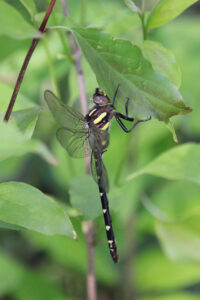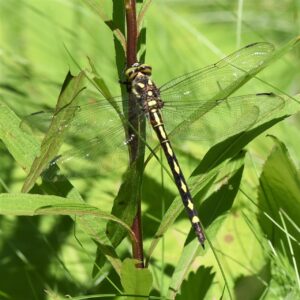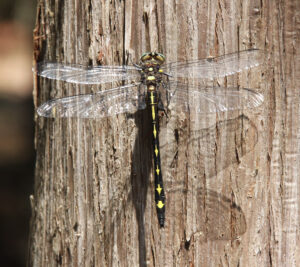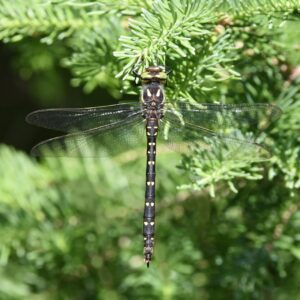Note: All links below go to external sites.
Howdy, BugFans,
What better time to write about dragonflies than in the depths of winter? The BugLady hasn’t officially spotted a spiketail. She knows where they live, and once, maybe, saw a Twin-spotted Spiketail zip past, but she only got a quick glimpse of it as it was leaving the scene. She stews about the species she’s going to mistake them for at a glance, like one of the mosaic darners or an Arrowhead Clubtail (what one blogger calls “possible confusables”).
Cordulegastridae, the Spiketails, is a whole new family for BOTW. Cordulegastridae comes from the Greek for “club-shaped belly” and “spiketail” comes from the impressive ovipositor wielded by the females. Thirty-three species of spiketails are found around the world; and eight (or nine, or ten of those, depending on which source you look at) live in North America, all in the genus Cordulegaster. Some have fairly broad ranges, and a few are quite localized, and as a group, they’re more eastern than western.

Three species are listed for Wisconsin – the Delta-spotted, which has only been reported from one county in northeastern Wisconsin, the Twin-spotted, and the Arrowhead Spiketail – and the BugLady would like to thank guest photographer, BugFan Freda (aka the Dragonfly Whisperer), for sharing her pictures of two of those.
They can be picky about habitat, preferring small, shallow, cold, clear streams with sandy or silty substrates and with plants along the edges, generally within woodlands. Some species thrive in “seeps” (wet areas where groundwater oozes out of the ground). They’re active from late spring to mid-summer. Kurt Mead, in Dragonflies of the North Woods calls them “secretive and not readily observed.”
Spiketails are large (2 ½” to 3 ½”), dark-colored dragonflies with un-patterned wings. The sexes are similar; they have yellow markings on their slim abdomen and yellow stripes on the thorax, and their medium-sized, bright blue-to-green eyes touch or almost touch at the top of their head. Their naiads have uneven, jagged teeth on their lower jaws.
Males are territorial, flying back and forth along the stream edge. Mating takes place in the treetops and may last as long as five hours (she doesn’t impale him because her ovipositor fits into a dedicated groove where his abdomen and thorax meet). Unlike many other dragonflies, the male does not stay attached to his female as she oviposits (the pogo stick action of the female as she jabs her eggs into the sand would make that a difficult feat, indeed https://www.youtube.com/watch?v=3BWy2nuixc4), but he patrols closely as she does. If the water is deeper than she is, hairs on her thorax will trap air bubbles that allow her to breathe underwater.
The naiads are burrowers, lurking under debris or digging into the soft silt until only their eyes are visible, waiting to ambush their prey (they back under, abdomen-first). Because the cold, clear water they live in may be relatively sterile, food-wise, some species take three to five years to mature. Spiketail naiads may be better equipped to handle a brief drying of their streams than a flood.
Naiads eat the immature mayflies, caddisflies, midges and blackflies that swim around with them; adults hunt for small insects in the treetops and wooded clearings, and they will pick insects off of vegetation (it’s called gleaning). They’re said to prefer beetles and bees.
Paulson, in Dragonflies and Damselflies of the East, suggests that spiketails are relatively easy to approach and photograph, but other authors point out their swift and ceaseless flying. When they perch (which is not often), they hang vertically or at an angle from a twig.
Read about the discovery of a new spiketail species in 2010 here.
TWIN-SPOTTED SPIKETAILS (Cordulegaster maculata) are the most common of the Wisconsin spiketails and are amenable to a variety of clean forest brooks, trout streams, and small rivers, even those with fish in them, as long as they are “stable” (not going to dry up).
At 2 ½” to 3” they’re a darner-sized dragonfly, named for the paired spots on the top of their abdomen. Newly-emerged (teneral) Twin-spotted Spiketails have gray eyes, but, writes Ohio naturalist and blogger Jim McCormac, “its eyes will become a brilliant emerald green, and it is quite cool to encounter an adult coursing low over the creek like a mini B-52 bomber. When they fly through a sunny opening, those eyes gleam like neon glow lights, visible from quite some distance.”
Paulson says that males fly “a few inches above water. Stand in water and they will fly around your legs.” They’re in the air all day and are more numerous in late afternoon.
Adults emerge in late spring here in God’s Country, and they’re more common in the northern two-thirds of the state. The naiad leaves the water and climbs up on a nearby log or tree to shed its skin (https://bugguide.net/node/view/18211/bgimage). They mate in the treetops, and according to Paulson, she may bob up and down as many as 100 times per minute while ovipositing. Naiads from eggs that are laid early in summer are mature when they overwinter, ready to emerge the next spring, sometimes in large numbers.

Congratulations to Freda for getting pictures of the ARROWHEAD SPIKETAIL (Cordulegaster obliqua) which is considered rare, local, and elusive. They are a shade larger than the Twin-spotted Spiketail, averaging just over three inches, with blue to green eyes (Southern populations tend to be larger, with blue eyes). The pale yellow markings on the top of the abdomen explain their name.
In late spring/early summer, males patrol along shallow, mud/silt/sand-bottomed springs or streams, a few feet above the water, around mid-day. Paulson notes that “Males clash when they meet.” Their naiads are able to survive occasional drying of the stream. When they’re not in flight, both males and females park, at an angle, on vegetation at the edge of a clearing, within a few feet from the ground.
They feed in woodland openings and edges and do not join feeding swarms with other dragonfly species – one source said that they may forage in the treetops or from low plant stems. Mead says that they are “wary and difficult to approach unless you can anticipate a male’s patrolling run. When disturbed, they fly straight up and disappear above the canopy.”

The BugLady is always tickled, when she researches insects, by the helpful side searches that pop up, especially “XX Insect Bite” (often about insects that pose no danger to humanity). Mead relates that “I get bitten by dragonflies in the hand all the time, but it’s almost always just a little pinch. It’ll get your attention, but no harm done….unless it’s an Arrowhead Spiketail. They don’t fly up and bite people but if handled carelessly, these beasts draw blood. Their jaws don’t have multiple jagged spikes on them like most dragonflies, but all of the energy of their powerful jaw is focused on a matching pair of stout spikes that make up their mouthparts.”
The good news is that, contrary to many dragonfly folk tales, they’re not in league with the devil, they don’t catch insects and feed them to snakes, and if you lie, cuss, or scold, the “Devil’s darning needle” won’t sew your eyes, lips or ears shut.
The BugLady
